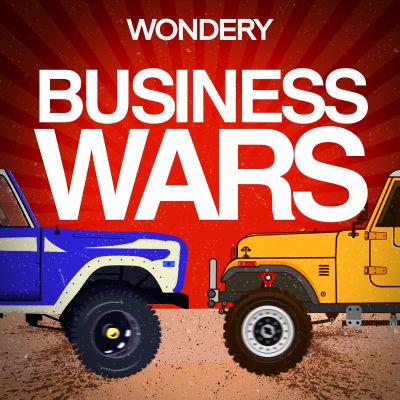Netflix vs. HBO. Nike vs. Adidas. Business is war. Sometimes the prize is your wallet or your attention. Sometimes, it’s just the fun of beating the other guy. The outcome of these battles shapes what we buy and how we live. Business Wars gives you the unauthorized, real story of what drives these companies and their leaders, inventors, investors and executives to new heights -- or to ruin. Hosted by David Brown, former anchor of Marketplace. From Wondery, the network behind Dirty John and American History Tellers.New episodes come out Wednesdays for free. Binge new full seasons early and ad-free, plus get exclusive past seasons, only with Wondery+.
https://www.wondery.com/shows/business-wars/?utm_source=rss
Gesamtlänge aller Episoden: 11 days 10 hours 57 minutes
recommended podcasts
- season 1
- season 2
- season 3
- season 4
- season 5
- season 6
- season 7
- season 8
- season 9
- season 10
- season 11
- season 12
- season 13
- season 14
- season 15
- season 16
- season 17
- season 18
- season 19
- season 20
- season 21
- season 22
- season 23
- season 24
- season 25
- season 26
- season 27
- season 28
- season 29
- season 30
- season 31
- season 32
- season 33
- season 34
- season 35
- season 36
- season 37
- season 38
- season 39
- season 40
- season 41
- season 42
- season 43
- season 45
- season 46
- season 47
- season 48
- season 49
- season 50
- season 51
- season 52
- season 53
- season 54
- season 55
- season 56
- season 57
- season 58
- season 59
- season 60
- season 61
- season 62
- season 63
- season 64
- season 65
- season 66
- season 67
- season 68
- season 69
- season 70
- season 71
- season 73
- season 74
- season 75
- season 76
- season 77
- season 78
- season 79
- season 80
- season 81
- season 82
- season 83
- season 84
- season 85
- season 86
- season 87
- season 88
- season 89
- season 90
- season 91
- season 92
- season 93
- season 94
- all
- 1
- 2
- 1
- 2
episode 1: Nintendo vs Sony - Stabbed in the Back
Once a symbol of 80s teenage nerdom, video games are now as common as television sets in American households. Can you imagine a world where the Sony PlayStation didn’t come out? That’s what almost happened. Originally conceived as a joint venture between Nintendo and Sony, the SNES-CD was supposed to be the bridge between Japan’s two largest tech companies. Instead, it drove the companies to war, an intense competition for entertainment domination that still goes on today...
episode 1: Hearst vs Pulitzer - The Headless Torso, Part 1
This is the beginning of a mystery, a great business rivalry, and a look into American history. To tell the story of Hearst vs Pulitzer, we called our friend Lindsay Graham over at American History Tellers for help. The Headless Torso mystery is about a jilted husband, a German midwife, a muscleman and more colorful characters...
episode 2: Nintendo vs Sony - Man of Steel
It's 1949. 22-year old Hiroshi Yamauchi is the heir apparent for his family's playing card company, Nintendo. From humble beginnings as a scrappy street stall founded in Kyoto's back alleys to the largest card company in Japan by the time Yamauchi takes over, this isn't a company that backs down easily when a little competition comes in. But it was a company that changed it's entire business over a couple of... cartoon characters...
episode 2: Hearst vs Pulitzer - The Headless Torso, Part 2
In 1897, America looked very different. Carriages rolled through the streets of New York. Mass media was just growing up, and Hearst was convinced that carrier pigeons - hunted to extinction by 1914 - were what would give his paper the edge during the early days of the Headless Torso case. This case belonged to the whole city. Everyone - barkeeps in Brooklyn and bankers on the Upper East Side alike are invested in the mystery… and what happened to his head...
episode 3: Nintendo vs Sony - Charm Offensive
From the moment it began, the PlayStation project was in danger. The problem was none other than PlayStations knight and chief advocate: Kutaragi. He thought the now-iconic handlebar controller design was “too different” from the flat rectangles people were used to. To make matters worse, PlayStation was getting closer and closer to launching without any games… a console with no games? Good luck with the PlayStation now, Sony. They were in trouble. And Nintendo knew it...
episode 3: Hearst vs Pulitzer - The Price of News
In 1883, 15 years before the Headless Torso Murder, New York City's population was rapidly growing and the newspaper scene was pretty sleepy. The city's nearly 50 daily papers, even the small New York Times, was a pretty sedate bunch, informing citizens about zoning board decisions and weather trends. They rarely draw any blood, stir up society, get the city talking. But that’s changing, thanks to Joseph Pulitzer. Support us by supporting our sponsors! See Privacy Policy at https://art19...
episode 4: Nintendo vs Sony - Game Time
This is a story about Sony and Nintendo, but it also involves a little company called Sega. Ever play Sonic the Hedgehog? That’s Sega. And during Nintendo’s domination of the US market, they were the only company able to fight back. That is, until they tried to outplay Sony. Support us by supporting our sponsors: Squarespace- Enter code BW at checkout to save 10% on your first website or domain at squarespace.com/BW.
episode 4: Hearst vs Pulitzer - War Drums
What happens when there’s no news? You have to MAKE the news. When Hearst heard from his top reporter that the Spanish-Cuban tension wasn’t looking like anything would happen, Hearst wasn’t just going to wait around for an explosion. He already bought and assembled a collection of powder kegs. It was just a matter of lighting the fuse. Support us by supporting our sponsors! See Privacy Policy at https://art19.com/privacy and California Privacy Notice at https://art19...
episode 5: Nintendo vs Sony - The Sleeping Giant
Nintendo decided early on that the Nintendo 64 would be a cartridge console, instead of a CD console. But CDs are much cheaper to make and have much better graphics. Game companies are upset, and defect to Sony. In a few months time, Sony has two of the most popular game series in Japan to itself. Nintendo will now have to make its own games that are strong enough to outsell PlayStation. It’s Nintendo vs the world. They’re taking a huge gamble, and this is not a game...
episode 5: Hearst vs Pulitzer - Newsies
A close up look at a crisis of their own making. One that nearly cost Hearst and Pulitzer their grip on the country’s first media empires. Instead of pitting them against each other, the crisis would see the two media moguls finding rare common ground. At the turn of the century, newspapers flew off the presses in 8 or 10 separate editions a day. Newsies grabbed them off stacks in the alleys and took to the streets, their little hands stained with ink...
- 1
- 2
- 1
- 2

